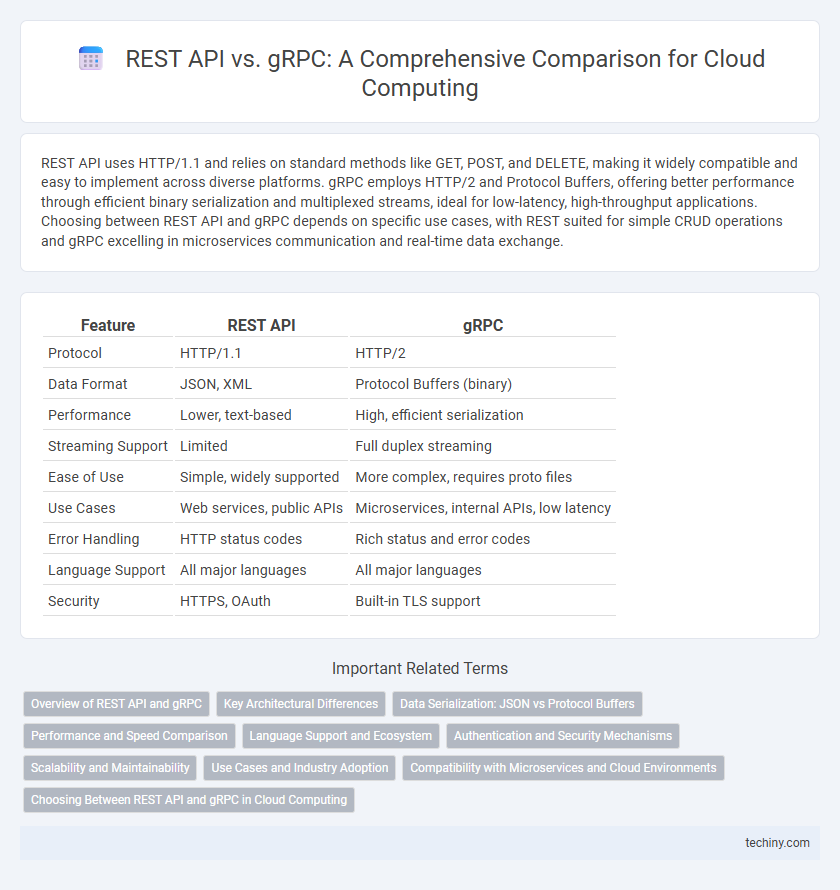REST API uses HTTP/1.1 and relies on standard methods like GET, POST, and DELETE, making it widely compatible and easy to implement across diverse platforms. gRPC employs HTTP/2 and Protocol Buffers, offering better performance through efficient binary serialization and multiplexed streams, ideal for low-latency, high-throughput applications. Choosing between REST API and gRPC depends on specific use cases, with REST suited for simple CRUD operations and gRPC excelling in microservices communication and real-time data exchange.
Table of Comparison
| Feature | REST API | gRPC |
|---|---|---|
| Protocol | HTTP/1.1 | HTTP/2 |
| Data Format | JSON, XML | Protocol Buffers (binary) |
| Performance | Lower, text-based | High, efficient serialization |
| Streaming Support | Limited | Full duplex streaming |
| Ease of Use | Simple, widely supported | More complex, requires proto files |
| Use Cases | Web services, public APIs | Microservices, internal APIs, low latency |
| Error Handling | HTTP status codes | Rich status and error codes |
| Language Support | All major languages | All major languages |
| Security | HTTPS, OAuth | Built-in TLS support |
Overview of REST API and gRPC
REST API relies on standard HTTP methods and stateless communication to enable interoperability between diverse systems, making it widely adopted for web services. gRPC uses HTTP/2 for transport and Protocol Buffers for efficient binary serialization, providing high performance and strong typing in microservices architectures. Both REST and gRPC play integral roles in cloud computing by supporting scalable and flexible API development.
Key Architectural Differences
REST API relies on HTTP/1.1 protocol and uses stateless, resource-based communication with standard methods like GET, POST, and DELETE, making it highly compatible with web browsers and easy to cache. gRPC leverages HTTP/2 for multiplexed, bidirectional streaming and transmits data in a compact binary format using Protocol Buffers, resulting in lower latency and higher performance. The architectural distinction centers on REST's human-readable JSON payloads and simple request-response model versus gRPC's efficient, contract-first approach designed for microservices and real-time communication.
Data Serialization: JSON vs Protocol Buffers
REST API commonly uses JSON for data serialization, which is human-readable and widely supported but can incur larger payload sizes and slower parsing speeds. gRPC employs Protocol Buffers, a compact, binary serialization format that enhances performance with smaller payloads and faster processing, ideal for high-throughput cloud services. Choosing between JSON and Protocol Buffers significantly impacts network efficiency and latency in cloud computing environments.
Performance and Speed Comparison
gRPC utilizes HTTP/2 and binary serialization, significantly enhancing performance and reducing latency compared to REST API's HTTP/1.1 and JSON text-based payloads. Benchmarks demonstrate gRPC achieves lower response times and higher throughput, making it ideal for real-time, high-frequency microservices communication. Although REST APIs offer broad compatibility and ease of use, gRPC's efficient protobuf serialization and multiplexed connections deliver superior speed and resource utilization in cloud computing environments.
Language Support and Ecosystem
REST API offers broad language support and a mature ecosystem with extensive libraries and tools across multiple platforms, making it highly accessible for diverse development teams. gRPC, designed with protocol buffers, provides excellent performance with native support in languages like Go, C++, Java, and Python, but its ecosystem is still growing compared to REST. The choice depends on project requirements, as REST's wide compatibility contrasts with gRPC's efficient binary communication and stronger integration in specific development environments.
Authentication and Security Mechanisms
REST API commonly uses OAuth 2.0 and API keys for authentication, enabling token-based access control and secure HTTPS communication to protect data in transit. gRPC supports authentication through SSL/TLS encryption, token-based authentication, and integration with external identity providers like Google Cloud IAM, offering robust mutual TLS capabilities for enhanced security between client and server. Both protocols emphasize secure authentication and encrypted communication, but gRPC's support for built-in mutual TLS provides stronger guarantees against man-in-the-middle attacks in microservices architectures.
Scalability and Maintainability
REST API offers broad compatibility with HTTP/1.1, enhancing scalability by easily integrating with caching layers and load balancers, while its stateless nature simplifies maintainability through clear separation of client-server responsibilities. gRPC, leveraging HTTP/2 and protocol buffers, delivers superior performance and scalability in microservices with efficient multiplexing and binary payloads, which also improves maintainability by enforcing strong contracts via service definitions. Both architectures support scalable cloud environments, but gRPC excels in high-throughput, low-latency scenarios, whereas REST remains ideal for wide interoperability and easier versioning.
Use Cases and Industry Adoption
REST API remains the dominant choice for web applications and public APIs due to its simplicity, wide language support, and compatibility with HTTP/JSON standards, making it ideal for mobile apps, IoT devices, and web services. gRPC, favored in microservices architecture and real-time communication, excels in low-latency, high-throughput environments, and is widely adopted by tech giants like Google and Netflix for internal APIs and cloud-native applications. Industries such as finance, healthcare, and e-commerce leverage REST for ease of integration, while gRPC drives performance-critical applications in telecommunications and gaming.
Compatibility with Microservices and Cloud Environments
REST API offers broad compatibility with microservices and cloud environments by leveraging standard HTTP protocols, enabling seamless integration and ease of use across diverse platforms. gRPC provides superior performance in cloud-native microservices through efficient binary serialization and HTTP/2 transport, supporting advanced features like bi-directional streaming and strong typing. Both technologies facilitate scalable and interoperable microservices architectures, with REST favoring simplicity and universal support, while gRPC excels in high-throughput, low-latency scenarios typical of modern cloud infrastructures.
Choosing Between REST API and gRPC in Cloud Computing
Choosing between REST API and gRPC in cloud computing depends on use case requirements such as performance needs, scalability, and interoperability. REST APIs offer simplicity, wide adoption, and compatibility with HTTP/1.1, ideal for web applications and public APIs, while gRPC provides higher efficiency, low latency, and support for multiple languages via HTTP/2 and Protocol Buffers, suitable for microservices and real-time communication. Evaluating factors like bandwidth constraints, message size, and protocol support ensures optimal cloud-native application performance and user experience.
REST API vs gRPC Infographic

 techiny.com
techiny.com